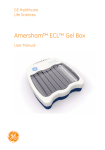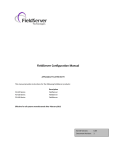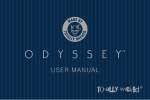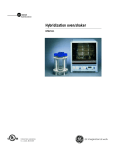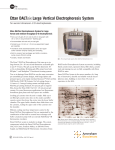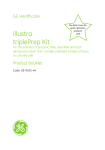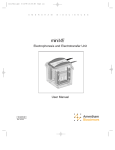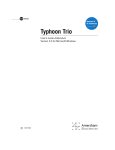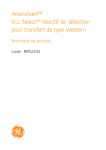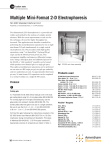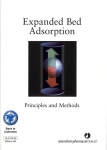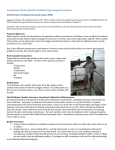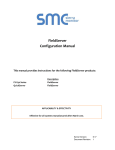Download ECL Plex Instruction Manual
Transcript
GE Healthcare Amersham ECL Plex Western blotting system Products listed below are optimized for use with ECL Plex Western Blotting System Product booklet Product ranges and codes: ECL Plex CyDye conjugated antibodies PA45009–PA45012, PA43009, PA45010 and 28901106–28901111 Hybond-LFP RPN2020LFP3, RPN2020LFP, RPN1416LFP and RPN303LFP Hybond-ECL RPN2020D, RPN78D, RPN203D and RPN3032D ECL Plex Fluorescent Rainbow markers RPN850E and RPN851E Blocking buffers RPN418 and RPN412 ECL Plex combination packs RPN998 and RPN999 Page finder 1. Important notes for working with fluorescence 4 2. Legal 5 3. Handling 3.1. Safety warnings and precautions 3.2. Storage 3.3. Expiry 3.4. Formulation and packaging 3.5. Recommendations for use 7 7 7 8 8 9 4. Components 4.1. Main components 4.2. Other materials required 10 10 10 5. Quality control 12 6. Description 13 7. Compatibility 7.1. Membranes 7.2. Blocking solutions 7.3. Fluorescent imaging systems 15 15 15 16 8. Protocols 8.1. Blotting protocol (wet electro transfer) 8.2. Single protein detection protocol 8.3. Multiplex detection protocol 8.4. Buffers and solutions 19 19 20 21 22 9. Scanning 23 10. Quantification 25 11. Additional information 11.1. Determination of optimum antibody concentration 11.2. Storage of probed membranes 11.3. Labelling of primary antibodies 26 26 27 27 2 11.4. Total protein staining of blots 11.5. Protocol for membrane stripping 27 27 12. Tips and troubleshooting when using the ECL Plex fluorescent Western blotting system 12.1. Handling membranes 12.2. Problems with high/uneven background and unspecific detection 12.3. Detection of low abundant proteins 30 31 13. Ordering information 13.1. ECL Plex products 13.2. Other materials required 13.3. Related products 32 32 35 36 3 29 29 1. Important notes for working with fluorescence Do not contaminate your blot with: • Coomassie blue stain • Ink from ball point pens • Bromophenol blue • Polyacrylamide gel fragments • Triton X-100 Always use powder free gloves and clean forceps and trays. 4 2. Legal GE, imagination at work and GE monogram are trademarks of General Electric Company. Amersham, Cy, CyDye, Deep Purple, ECL Advance, ECL Plex, ECL Plus, Ettan, Hybond, Hybond LFP, ImageQuant, PlusOne, Rainbow, Storm and Typhoon are trademarks of GE Healthcare companies. All third party trademarks are the property of their respective owners. CyDye: This product or portions thereof is manufactured under an exclusive license from Carnegie Mellon University under US patent number 5,268,486 and equivalent patents and patent applications in other countries. The purchase of CyDye products includes a limited license to use the CyDye products for internal research and development but not for any commercial purposes. A license to use the CyDye products for commercial purposes is subject to a separate license agreement with GE Healthcare. Commercial use shall include: 1. Sale, lease, license or other transfer of the material or any material derived or produced from it. 2. Sale, lease, license or other grant of rights to use this material or any material derived or produced from it. 3. Use of this material to perform services for a fee for third parties, including contract research and drug screening. If you require a commercial license to use this material and do not have one, return this material unopened to GE Healthcare Bio-Sciences AB, Bjorkgatan 30, SE-751 84 Uppsala, Sweden and any money paid for the material will be refunded. 5 Deep Purple Total Protein Stain Deep Purple Total Protein Stain is exclusively licensed to GE Healthcare from Fluorotechnics Pty Ltd. Deep Purple Total Protein Stain may only be used for applications in life science research. Deep Purple is covered under a granted patent in New Zealand entitled “Fluorescent Compounds”, patent number 522291 and equivalent patents and patent applications in other countries. © 2006-2007 General Electric Company – All rights reserved. Previously published 2006 All goods and services are sold subject to the terms and conditions of sale of the company within GE Gealthcare which supplies them. a copy of these terms and conditions is available on request. Contact your GE healthcare representative for the most current information. http://www.gehealthcare.com/lifesciences GE Healthcare UK Limited. Amersham Place, Little Chalfont, Buckinghamshire, HP7 9NA UK 6 3. Handling 3.1. Safety warnings and precautions 3.2. Storage On receipt store the lyophilized ECL Plex™ CyDye™ conjugated secondary antibodies at 2-8˚C protected from light. Reconstitute in ultra pure water to a concentration of 1 μg/μl, and keep aliquots at -15˚C to -30˚C protected from light. Avoid repeated freeze-thaw cycles. Warning: For research use only. Not recommended or intended for diagnosis of disease in humans or animals. Do not use internally or externally in humans or animals. All chemicals should be considered as potentially hazardous. We therefore recommend that this product is handled only by those persons who have been trained in laboratory techniques and that it is used in accordance with the principles of good laboratory practice. Wear suitable protective clothing such as laboratory overalls, safety glasses and gloves. Care should be taken to avoid contact with skin or eyes. In the case of contact with skin or eyes wash immediately with water. See material safety data sheet(s) and/or safety statement(s) for specific advice. The membranes are provided in airtight re-sealable aluminium bags to prevent adsorption of moisture and other airborne contaminants. The membrane should be stored in the sealed bag at room temperature in a clean dry place. The ECL Plex Fluorescent Rainbow markers™ should be stored at -15˚C to -30˚C. Avoid repeated freeze-thaw cycles. 7 3.3. Expiry 3.4. Formulation and packaging The reconstituted ECL Plex CyDye conjugated secondary antibodies are stable for at least 6 months when stored under recommended conditions. The ECL Plex CyDye conjugated secondary antibodies are supplied in light-tight containers as a lyophilized solid in Phosphate-Buffered Saline (0.02 M Potassium Phosphate, 0.15 M NaCl) pH 7.2, containing 1% (w/v) Bovine Serum Albumin and 0.1% (w/v) Sodium Azide. The tubes containing the antibodies have color coded caps to facilitate discrimination between Cy™2, Cy3 and Cy5 antibody conjugates. The membranes are stable for at least 1 year before opening and once opened the performance is consistent for at least 3 months when stored under the recommended conditions. The ECL Plex Fluorescent Rainbow markers is stable for at least 3 months when stored under the recommended conditions. The membranes are packed in air-tight re-sealable aluminium bags. The ECL Plex Fluorescent Rainbow markers is supplied in 30% glycerol and sample buffer containing mercaptoethanesulphonic acid (MESNA) as reducing agent. 8 3.5. Recommendations for use Use 1.5–3 μl of ECL Plex Fluorescent Rainbow markers per 10 x 10 cm mini gel. Some bands of the ECL Plex Rainbow markers may appear weaker when scanned in the Cy3 channel. The ECL Plex Rainbow markers are not visible in the Cy2 channel. If your blot is only probed with ECL Plex Cy3 or Cy2 conjugated antibody, perform an additional scan in the Cy5 channel if needed. The recommended dilution for the ECL Plex CyDye conjugated secondary antibodies (1 μg/μl) is 1/2500, but the optimal concentration (between 1/1250–1/4000) should be determined for each Western blotting experimental setup. For blocking and antibody incubations, use sufficient volume to cover the membranes (at least 0.3 ml/cm2) 9 4. Components 4.1. Main components 4.2. Other materials required • ECL Plex CyDye conjugated antibodies - PA45009– PA45012, PA43009, PA45010 and 28901106–20901111 • SDS PAGE gels • Electrophoresis system* • Transfer Unit* • Typhoon™ or other Fluorescent laser scanner* (for specific requirements, see page 15) • Hybond-LFP™ RPN2020LFP3, RPN2020LFP, RPN1416LFP and RPN303LFP • Image analysis software* • Hybond™-ECL - RPN2020D, RPN78D, RPN203D and RPN3032D • Power Supply* • Hybond blotting paper* • Methanol • ECL Plex Fluorescent Rainbow markers - RPN850E and RPN851E • Tris* • Glycine* • Tween™ 20* • Blocking buffers - RPN418 and RPN412 • SDS* • DTT* • ECL Plex combination packs - RPN998 and RPN999 • Glycerol* • Bromophenol blue* See ordering information section for a detailed description of the above products. • PBS (Phosphate-Buffered Saline)* • Protein Quantification Kit* • Trays/dishes 10 • Basic laboratory equipment • Orbital shaker * Products available from GE Biodirectory, see ordering information. 11 5. Quality control Every batch of ECL Plex CyDye conjugated secondary antibody and Hybond-LFP membrane is functionally tested in fluorescent western blotting application (ECL Plex) to ensure minimal batch to batch variation. The antibody product was prepared from monospecific antiserum by immunoaffinity chromatography using mouse/rabbit IgG immobilized to agarose beads. This was followed by multiple solid phase adsorptions to eliminate cross reactivity. A single precipitin arc was observed against anti-goat serum, mouse/rabbit IgG and mouse/rabbit serum when assayed by immunoelectrophoresis. No reaction was observed against calf, chicken, goat, guinea pig, hamster, horse, human, rabbit, mouse, and rat or sheep serum proteins. The ECL Plex Fluorescent Rainbow markers is assessed for color intensity and band integrity on a 4-20% gradient SDS-PAGE minigel. 12 6. Description The ECL Plex Western blotting system is optimized for single protein detection as well as multiplex protein detection using ECL Plex CyDye conjugated secondary antibodies and Hybond-LFP (low fluorescent PVDF membrane), or Hybond-ECL (nitrocellulose membrane). The optimized antibodies show high sensitivity, a very good dynamic range and low or no cross reactivity. The CyDye technology is safe and reliable and ensures accurate quantification. The system is optimized on the Typhoon scanner but is compatible with many fluorescent laser scanners and CCD cameras (see section 7). The ECL Plex Fluorescent Rainbow markers is a mixture of individually colored proteins of defined size. Purified proteins are combined to produce bands of equal color intensity and even spacing when separated on a polyacrylamide gel. The visibility of the individual marker bands in the Cy3 or Cy5 can vary and depend on the primary antibodies used. 13 Fig 1. The ECL Plex Rainbow markers were separated on a 4-20% gradient polyacrylamide gel and transferred to a membrane. Cy5/ Cy3 overlaid (A), Cy3 (B), Cy5 (C) and visual (D) images from the blot are shown. 14 7. Compatibility The ECL Plex Western blotting system is compatible with nitrocellulose and low fluorescent PVDF membranes, multiple blocking solutions and fluorescent laser scanners, imagers. 7.1. Membranes Hybond-ECL and Hybond-LFP membranes are optimized and recommended for use with the ECL Plex Western blotting system. For low abundant protein analysis, the Hybond-LFP membrane is recommended. If stripping is required, the Hybond-LFP is the recommended choice. 7.2. Blocking solutions Many blocking solutions are compatible (see Table 1), but the use of ECL Advance™ blocking agent in wash buffer (first choice) or 5% Bovine Serum Albumin in PBS/TBS is recommended. In case of unspecific detection, we recommend the use of 2% ECL Advance blocking agent in wash buffer to reduce the problems. Table 1. Compatibility of blocking solutions. Membrane 2% ECL 5% BSA 5% BSA in 10% 2% ECL 5% ECL5% ECL blocking Advance* in PBS Gelatine PBS/TBS advance* blocking blocking agent in wash agent in wash buffer buffer Hybond LFP ++ ++++ +++ - Hybond ECL ++ +++ +++ - 15 * This blocker can reduce unspecific detection ++++ = high performance +++ = good performance ++ = acceptable performance + = poor performance - = not compatible Ratings are based on overall performance including level of auto fluorescence/background and unspecific detection as well signal intensity 7.3. Fluorescent imaging systems Imaging systems with the capability of detecting Cy2, Cy3 and Cy5 are compatible with the ECL Plex Western blotting system; however, the ECL Plex CyDye coupled secondary antibodies have been optimized using Typhoon, Ettan™ DIGE and Storm™ Imagers. Performance may vary depending on the imager used (see Table 2). 16 Table 2. Examples of the compatibility of ECL Plex CyDye conjugated antibodies with membranes and scanners. Imager Membrane ECL Plex CyDye conjugated antibodies Goat-α-mouse/ Goat-α-mouse/ Goat-α-mouse/ rabbit lgG-Cy2 rabbit lgG-Cy3 rabbit lgG-Cy5 Typhoon and Typhoon EttanTM DIGE Hybond-LFP Imager Hybond-ECL Hybond-LFP Storm 860 Hybond-ECL Biorad Molecular Imager Hybond-LFP Imager FX FX Pro/Pro SystemsPlus Hybond-ECL ++++ +++ NA +++ +++ ++ NA ++ NT ++++ ++++ ++ ++ NT ++++ ++++ NT ++ ++ Hybond-LFP +++ +++ +++ Hybond-ECL ++ ++ ++ Fuji FLA Imagers Hybond-ECL Kodak Image Station 2000MM ++++ ++(+) +++ NT Hybond-LFP TM +++(+) TM Li-Cor Hybond-LFP NA NA +++ OdysseyTM Hybond-ECL NA NA ++ 17 ++++ = high performance +++ = good performance ++ = acceptable performance + = poor performance NA = not compatible NT = not tested Ratings are based on overall performance including level of auto fluorescence/background and unspecific detection as well signal intensity 18 8. Protocols 8.1. Blotting protocol (wet electro transfer) Any type of transfer system for Western blotting is possible to use, but we recommend the use of electro transfer/wet transfer (see other materials required/related products). 1 . Separate the protein samples and molecular weight standards using SDS-PAGE (1 mm gel thickness) electrophoresis. 2. Carefully remove the stacking gel and the Bromophenol Blue front and soak the gel in cold transfer buffer for 10–20 minutes. 3. Cut the membrane into suitable size and prepare it for blotting. Wet Hybond ECL (nitrocellulose) membranes in ultra pure water for 20 seconds followed by 5 minutes in pre-chilled transfer buffer. Wet Hybond-LFP (PVDF) membranes first in methanol for 20 seconds, then in ultra pure water also for 20 seconds and finally in cold transfer buffer for at least 5 minutes. 4. Place the electro cassette anodic side facing down in a tray filled 3 cm deep with pre chilled transfer buffer. Load the cassette starting at the anodic side with a foam sponge, followed by two Hybond blotting papers (pre wetted in transfer buffer), the prepared membrane, the gel, and again two wet Hybond blotting papers and finally a second foam sponge. Make sure to remove any trapped air between filter papers, membrane and gel. Close the cassette and place the anodic side (+) in the same orientation as the following cassettes in the electro blotting tank filled with cold transfer buffer. Make sure to connect the + end of the cables of the lid of the transfer buffer tank to the + labelled sockets of the power supply. 19 5. Transfer at 25 V (maximum 400 mA) and 4˚C with stirring for 2–2.5 hours. 6. Block the membrane in 2% ECL Advance blocking agent in wash buffer, shaking at 4˚C over night or at room temperature for 1 hour. 7. After blocking, rinse the membrane twice in PBS-T and then wash 2 x 5 minutes. Keep the membrane in wash buffer or wash buffer without Tween 20 (for longer times than 3 days) until probed with primary and secondary antibodies (see sections 8.2 and 8.3). Blotted membranes can be stored at 4˚C in wash buffer without Tween 20 for up to one week before probing. 8.2. Single protein detection protocol 1. Dilute the primary antibody of mouse or rabbit origin to optimal concentration in wash buffer or blocking solution (see additional information). 2. Incubate a blocked membrane (protein side up) with the diluted primary antibody for 1.5 hours at room temperature, shaking. 3. Rinse the membrane twice in wash buffer, then wash the membrane for 2 x 5 minutes in wash buffer shaking at room temperature. 4. Dilute the ECL Plex CyDye conjugated secondary antibodies (1 μg/μl) to optimal concentration (between 1:1250 and 1:4000, we recommend 1:2500, see additional information) in wash buffer. Incubate the washed membrane protected from light for 1 hour at room temperature, shaking. 5. Rinse the membrane three times in wash buffer, followed by 4 x 5 minutes in wash buffer, shaking at room temperature and protected from light. 20 6. Rinse the membrane three times in wash buffer (without Tween 20). 7. Detect the secondary antibody signal by scanning the membrane using a fluorescent laser scanner. If Hybond-LFP membrane is used, dry the membrane before scanning by placing it on Hybond blotting paper and incubate at 37˚C to 40˚C for 1 hour or at room temperature over night protected from light. If stripping is planned, remember to NOT dry the Hybond-LFP membrane. 8.3. Multiplex detection protocol 1. Dilute the primary antibodies of mouse and rabbit origin to optimal concentrations in wash buffer or blocking solution (see additional information). 2. Incubate the blocked membrane (protein side up) with both diluted primary antibodies together for 1.5 hours shaking at room temperature. If primary antibodies are to be reused, it is possible to incubate the primary antibodies separately when multiplexing. 3. Rinse the membrane twice in wash buffer, then wash the membrane for 2 x 5 minutes in wash buffer at room temperature, shaking. 4. Dilute the ECL Plex CyDye conjugated secondary antibodies (1 μg/μl) to optimal concentration (between 1:1250 and 1:4000, we recommend 1:2500, see additional information) in wash buffer. Incubate the washed membrane protected from light for 1 hour at room temperature, shaking. 21 5. Rinse the membrane three times in wash buffer, followed by 4 x 5 minutes in the same buffer shaking at room temperature and protected from light. 6. Rinse the membrane three times in wash buffer (without Tween 20). 7. Detect the multiplexed secondary antibody signals by scanning the membrane using a fluorescent laser scanner or imager. If HybondLFP membrane is used, dry the membrane before scanning by placing it on Hybond blotting paper and incubate at 37˚C to 40˚C for 1 hour or at room temperature over night protected from light. If stripping is planned, remember to NOT dry the Hybond-LFP membrane. 8.4. Buffers and solutions • Sample loading buffer: 120 mM Tris pH 6.8, 20% Glycerol, 4% SDS, 200 mM DTT and trace amount of Bromophenol blue. • Running buffer: 25 mM Tris, 192 mM Glycine and 0.1% SDS. • Ultrapure water. • Transfer buffer: 25 mM Tris, 192 mM Glycine, 20% Methanol. • Blocking solution: 2% ECL Advance blocking agent in wash buffer. • Wash buffer: PBS pH 7.4, 0.1% Tween (PBS-T) or TBS pH 7.4-8, 0.1% Tween (TBS-T). TBS-T is recommended for detection of phosphorylated proteins. • PBS pH 7.4 or TBS pH 7.4-8. TBS is recommended for detection of phosphorylated proteins. 22 9. Scanning We recommend the scanning of dried membranes. However, Hybond-ECL membranes (nitrocellulose) can become fragile when dried. If this is the case, we recommend scanning the membrane while wet. Scanning dried membranes usually results in a more even background and a higher signal to noise ratio. Note: Always place the membranes with the protein side facing down on the scanner bed. 1. Dried membranes: Place a low fluorescent glass plate on top of the membranes when scanning dried membranes. Make sure to label the dried Hybond-LFP membranes by cutting corners or using a pencil, because they can easily lose their position on the scanner bed during handling. 2. Wet membranes: To minimize the formation of air bubbles when scanning wet membranes, a small amount of water should be placed on the scanner bed prior to applying the membrane (protein side down). Also, roll an empty 10 ml pipette or similar across the membrane on the scanner bed to remove any trapped air. For the Typhoon scanner use the Cy3 and Cy5 channels and a PMT value between approximately 500 and 700 V for wet membranes and 300 to 500 V for dry membranes. It is critical to use the green (532) laser and 580 BP 30 Cy3 TAMRA filter setting for optimal Cy3 detection. If the 555 BP 20 Cy3 (Typhoon 8600) filter is used the signal becomes much weaker and the sensitivity is decreased. Also, background becomes much higher if the sub-optimal filter is used for Cy3 detection. For Cy5 detection, use the red (633) laser and 670 BP 30 filter setting and for Cy2 use the blue (488) laser and 23 520 BP 40 filter setting. For the Ettan DIGE Imager use the cassette with permanently mounted glass and the black plastic hold down plate to scan membranes. Remember to choose Matrix TypeMembrane in the scanner software prior to scanning. Then choose Cy2, Cy3 or Cy5 channels and exposure levels. The procedure for scanning membranes using Storm Imager is similar to Typhoon. The Storm Imager can detect Cy5 and Cy2, but not Cy3. For operating procedures for the different scanners, see Typhoon’s User’s Guide (code no. 63–0028–31), Ettan DIGE Imager User Manual (code no. 11–0036–59) or Storm Instrument Guide (no. 363–367). The DIGE naming format is useful when scanning a multiplexed membrane. • It is important to clean the Typhoon scanner bed after use, especially after scanning of DIGE gels to avoid contaminating the membranes. We recommend that the glass platen is first cleaned with 10% hydrogen peroxide followed by 75% ethanol and finally distilled water. 24 10. Quantification For accurate quantification of the proteins of interest, the image analysis software called ImageQuant™ TL from GE Healthcare is recommended. Other software programs are also compatible. 25 11. Additional information 11.1. Determination of optimum antibody concentration Primary antibody 1. Make a serial dilution of the protein that the primary antibody is directed against. Secondary antibody 1. Make a serial dilution of the protein that the primary antibody is directed against. 2. Perform dot blot or perform full Western blotting procedure. Block the membranes. 2. Perform dot blot or perform full Western blotting procedure. Block the membranes. 3. Wash and incubate the membranes with several dilutions of the primary antibody, for example 1:100, 1:500, 1:1000 and 1:5000. 3. Wash and incubate the membranes with the optimal dilution of the primary antibody. 4. Wash and incubate the membranes with the secondary antibody in the same dilution for all dilutions of primary antibody. 4. Wash and incubate the membranes with several dilutions of the secondary antibody, for example 1:1250, 1:1500, 1:2500, 1:3500 and 1:4000. 5. Select the optimal dilution as the maximal signal to noise ratio. 5. Select the optimal dilution as the maximal signal to noise ratio. 26 11.2. Storage of probed membranes The membrane can be stored in dried condition between two blotting papers wrapped in foil at ambient temperature for at least 3 months. Remember that the Hybond-ECL membrane may become fragile when dry. 11.3. Labelling of primary antibodies Cy3 and Cy5 labelled primary antibodies could also be prepared (using CyDye antibody labelling kits or CyDye-esters: see under related products), but the sensitivity is likely to be lower than using indirect detection (i.e. unlabelled primary antibody with ECL Plex CyDye conjugated secondary antibodies). 11.4. Total protein staining of blots The blots can be reversibly stained with Deep Purple™ to confirm transfer (see instructions for Deep Purple Total Protein Stain). Deep Purple is detectable using the Typhoon. 11.5. Protocol for membrane stripping Following fluorescent detection using the ECL Plex Western blotting system it is possible to re-probe the Hybond-LFP (PVDF) membrane several times. If stripping is planned for, remember to NOT dry the membranes. When scanning wet Hybond-LFP membranes the background will be higher and can appear uneven (due to partial dryness). The membranes can be stored in PBS at 2˚C to 8˚C for up to 3 months. It is not recommended to strip and re-probe Hybond-ECL (nitrocellulose) membranes. 27 Protocol for membrane stripping: Incubate the membrane in 100 mM β-mercaptoethanol, 2% SDS, 62.5 mM Tris-HCl pH 6.8 shaking for 30 minutes at 50˚C. Wash the membrane 2 x 10 minutes in wash buffer shaking at room temperature. Block and re-probe the membrane according to recommended protocols. 28 12. Tips and troubleshooting when using the ECL Plex fluorescent Western blotting system 12.1. Handling of membranes • Always use powder free gloves. Powder from the gloves can give rise to contamination on fluorescent images of membranes. • Do not use a ball point pen on the membrane, since it can contaminate other membranes in the same tray and is visible upon fluorescent scanning. If you need to write something on the membrane use a pencil. • Do not touch membranes probed with the secondary antibody with gloved hands. This could leave marks on the fluorescent image. Always use forceps (slide forceps is recommended) when handling the membranes. • Make sure to always keep the protein side of the membranes up throughout the protocol. Remember to scan the membranes with protein side facing down on the scanner bed. • Make markings by cutting, for example, corners on the membrane to avoid mixing up when handling them. This is also very useful in a multi-membrane scan to be able to discriminate them from each other during image analysis. 29 12.2. Problems with high/uneven background and unspecific detection • Make sure to remove the stacking gel before transfer. Also, make sure to remove any small pieces of gel after transfer before blocking the membrane. Any remaining gel pieces can give rise to black spots on fluorescent images of the membranes. • Remove all bromophenol blue (BFB) in the front from the SDS-PAGE gel before transfer. BFB on the membrane can give fluorescent signals. • Make sure that your trays are clean and not contaminated by for example Coomassie™ blue stain, which can cause background problems. • If you have problems with detection of many unspecific protein bands, we recommend using Hybond-LFP membrane. The use of 2% ECL Advance blocking agent may further reduce unspecific detection. This problem is often dependent on the primary antibody. • A common reason for uneven background is that the membrane is only partly dried. Make sure that the membrane is completely dry when scanned. If the Hybond-ECL membranes are scanned wet, it is important to ensure that the membrane has not partially dried during handling. • It can be advantageous to incubate the primary antibodies diluted in blocking solution, to reduce unspecific binding and increase signal intensity. For some primary antibodies diluted in blocking solution, a lower concentration of antibodies can result in a much stronger signal compared to when diluted in wash buffer (even at a higher concentration). For other primary antibodies there is no difference in signal intensity when diluted in blocking solution. 30 12.3. Detection of low abundant proteins • Use ECL Plex Cy5 conjugated secondary antibody for the protein you expect to have the lowest concentration in your sample. The ECL Plex Cy5 secondary antibody is slightly more sensitive than the ECL Plex Cy3 secondary antibody and the ECL Plex Cy2 secondary antibody. • When detecting low abundant proteins, the signal can for a few target proteins become stronger if the species of primary antibody is switched in addition to careful optimization of antibody dilution. Sometimes the signal for the protein of interest can become stronger using an anti-mouse instead of an anti-rabbit primary antibody and vice versa. • For improved detection of weak signals using the Hybond-LFP membrane, skip the blocking step and instead dry the membrane directly after transfer. Dry the membrane for at least 2 hours at ambient temperature. Another tip for increasing weak signals is to use PBS 0.1% Triton X-100 instead of PBS 0.1% Tween 20 throughout the protocol. However, Triton is NOT compatible with the Cy3 channel (high background). • If you are detecting low abundant proteins, use a smaller amount of ECL Plex Rainbow Markers (1.5 μl) or leave an empty lane between the markers and the sample. The markers can otherwise appear too strong and even disturb the analysis of the sample lane. • TBS and TBS-T is recommended for use with antibodies against phosphorylated proteins. The phosphorate in PBS buffer can interfere and reduce the antibody binding. 31 13. Ordering information 13.1. ECL Plex products ECL Plex Cy3 and Cy5 conjugated antibodies Code no. ECL Plex goat-α-mouse IgG, Cy5, 150 μg Recommended for at least 1000 cm2 membrane PA45009 ECL Plex goat-α-mouse IgG, Cy5, 600 μg Recommended for at least 4000 cm2 membrane PA45010 ECL Plex goat-α-rabbit IgG, Cy5, 150 μg Recommended for at least 1000 cm2 membrane PA45011 ECL Plex goat-α-rabbit IgG, Cy5, 600 μg Recommended for at least 4000 cm2 membrane PA45012 ECL Plex goat-α-mouse IgG-Cy3, 150 μg Recommended for at least 1000 cm2 membrane PA43009 ECL Plex goat-α-mouse IgG-Cy3, 600 μg Recommended for at least 4000 cm2 membrane PA43010 ECL Plex goat-α-rabbit IgG-Cy3, 150 μg Recommended for at least 1000 cm2 membrane 28901106 ECL Plex goat-α-rabbit IgG-Cy3, 600 μg Recommended for at least 4000 cm2 membrane 28901107 ECL Plex goat-α-mouse IgG-Cy2, 150 μg Recommended for at least 1000 cm2 membrane 28901108 ECL Plex goat-α-mouse IgG-Cy2, 600 μg Recommended for at least 4000 cm2 membrane 28901109 ECL Plex goat-α-rabbit IgG-Cy2, 150 μg Recommended for at least 1000 cm2 membrane 28901110 ECL Plex goat-α-rabbit IgG-Cy2, 600 μg Recommended for at least 4000 cm2 membrane 32 28901111 Hybond-ECL, Low fluorescent nitrocellulose membrane. Optimized for use with ECL Plex Western Blotting System. Code no. Hybond-ECL, 20 x 20 cm, 10 sheets RPN2020D Hybond-ECL, 7 x 8 cm, 50 sheets RPN78D Hybond-ECL, 20 cm x 3 m, 1 roll RPN203D Hybond-ECL, 30 cm x 3 m, 1 roll RPN303D Hybond-ECL, 30 cm x 3 m, 1 roll RPN3032D* *0.2 μm pore size Hybond-LFP, Low fluorescent PVDF membrane, 0.2 μm pore size. Optimized for use with ECL Plex Western Blotting System. Code no. Hybond-LFP, 20 x 20 cm, 3 sheets RPN2020LFP3 Hybond-LFP, 20 x 20 cm, 10 sheets RPN2020LFP Hybond-LFP, 14 x 16 cm, 15 sheets RPN1416LFP Hybond-LFP, 30 cm x 3 m, 1 roll RPN303LFP ECL Plex Fluorescent Rainbow markers; full-range. Optimized for use with ECL Plex Western Blotting system. Supplied in gel loading buffer. Defined molecular weight standards from 12,000 to 225,000 kD. Code no. ECL Plex Fluorescent Rainbow markers; full range, 120 μl RPN850E ECL Plex Fluorescent Rainbow markers; full range, 500 μl RPN851E 33 ECL Plex Western blotting combination pack; Code no. Cy3, Cy5, Hybond-ECL RPN998 Combination pack optimized for ECL Plex Western blotting including Hybond-ECL (nitrocellulose membrane). Contains the following components, sufficient for at least 1000 cm2 of membrane: ECL Plex goat-α-mouse IgG, Cy3, 150 μg ECL Plex goat-α-rabbit IgG, Cy5, 150 μg ECL Plex Fluorescent Rainbow markers, full-range 120 μl Hybond-ECL, 10 x 10 cm, 10 sheets ECL Plex Western blotting combination pack; Code no. Cy3, Cy5, Hybond-LFP RPN999 Combination pack optimized for ECL Plex Western blotting including Hybond LFP (low fluorescent PVDF membrane). Contains the following components, sufficient for at least 1000 cm2 of membrane: ECL Plex goat-α-mouse IgG, Cy3, 150 μg ECL Plex goat-α-rabbit IgG, Cy5, 150μg ECL Plex Fluorescent Rainbow markers, full-range 120 μl Hybond-LFP, 20 x 20 cm, 3 sheets Blocking buffer, optimized for use with ECL Plex Western Blotting system Code no. ECL Advance Blocking agent, 20 g RPN418 Bovine Serum Albumin, 25 g RPN412 34 13.2. Other materials required Code no. MiniVE vertical Electrophoresis system 80-6418-77 TE 22 Mini tank Transfer Unit Typhoon 9410 Ettan DIGE Imager Ettan DIGE Imager cassette with low fluorescent glass for naked gels 80-6204-26 63-0055-80 63-0056-42 Storm 860 and ImageQuant TL 63-0035-63 EPS 301 Power Supply 18-1130-01 11-0027-33 Hybond blotting paper RPN6101M PlusOne™ Tris 17-1321-01 PlusOne Glycine 17-1323-01 PlusOne Tween 20 17-1316-01 PlusOne SDS 17-1313-01 PlusOne DTT 17-1318-01 PlusOne Glycerol 17-1325-01 PlusOne Bromophenol blue (BFB) 17-1329-01 2D Quant Kit 80-6483-56 Methanol SDS PAGE gels Trays/dishes Basic laboratory equipment Orbital shaker 35 13.3. Related products Code no. TE 70 PWR ECL Semi-Dry Transfer Unit 11-0013-41 TE 77 PWR ECL Semi-Dry Transfer Unit 11-0013-42 TE 70 ECL Semi-Dry Transfer Unit 80-6210-34 TE 77 ECL Semi-Dry Transfer Unit 80-6211-86 TE 62 Transfer Unit 80-6209-58 ImageQuant Analysis Software 63-0050-72 ECL Western blotting system RPN2108 ECL Plus™ Western blotting detection reagent RPN2132 ECL Advance Western blotting detection kit, includes ECL Advance blocking agent RPN2135 ECL mouse IgG, HRP-linked whole ab NA931 ECL rabbit IgG, HRP-linked whole ab NA934 ECL Western blotting reagents RPN2109 ECL Multiprobe 11-0033-95 ECL Multiprobe XL 11-0033-96 Deep Purple Total Protein Stain RPN6305, RPN6306 Antibody labeling kit, using bis-Reactive CyDye: Code no. Cy2 Ab labelling kit PA32000 Cy3 Ab labelling kit PA33000 Cy5 Ab labelling kit PA35000 Bis-Reactive CyDye NHS esters: Code no. Cy5.5 NHS ester PA15500 Cy7 NHS ester PA17000 36 Monoclonal antibody labeling kit, using mono-Reactive CyDye: Code no. Cy3 Ab labelling kit PA33001 Cy5 Ab labelling kit PA35001 Mono-Reactive CyDye NHS esters: Code no. Cy3.5 NHS ester PA13605 Cy5.5 NHS ester PA15605 Cy7 NHS ester PA17105 37 GE Healthcare offices: GE Healthcare Bio-Sciences AB Björkgatan 30 751 84 Uppsala Sweden GE Healthcare Europe GmbH Munzinger Strasse 5 D-79111 Freiburg Germany GE Healthcare Bio-Sciences Corp 800 Centennial Avenue P.O. Box 1327 Piscataway NJ08855-1327 USA GE Healthcare Bio-Sciences KK Sanken Bldg. 3-25-1, Hyakunincho Shinjuku-ku, Tokyo 169-0073 Japan For contact information for your local office, please visit: www.gelifesciences.com/contact http://www.gehealthcare.com/lifesciences GE Healthcare UK Limited Amersham Place Little Chalfont Buckinghamshire HP7 9NA UK imagination at work PA43009PL Rev C 07/2007 Amersham ECL Plex Western blotting system Product protocol card PA43009 2006 1. Run an SDS-PAGE gel loaded with with your samples diluted in sample loading buffer and heated to 96˚C for 5 minutes. Apply 1.5-3 μl ECL Plex RainbowTM markers without pre-heating. 2. Blot the gel onto a HybondTM-LFP or Hybond-ECL membrane using electro transfer (wet transfer) at 25 V for approximately 2.5 hours. 3. Block the membrane in 2% ECL Advance blocking agent in wash buffer for 1 hour at RT or overnight at 4˚C, shaking. 4. Rinse the membrane twice followed by 2 x 5 minutes in wash buffer at RT, shaking. 5. Incubate the membrane with an optimized dilution (in wash buffer or blocking solution) of primary antibodies for at least 1.5 h at RT or at overnight at 4˚C, shaking. 6. Rinse the membrane twice followed by 2 x 5 minutes in wash buffer at RT, shaking. 7. Incubate the membrane with an optimized dilution (between 1:1250 and 1:4000. 1:2500 dilution is a recommended starting point) of ECL Plex CyDye-conjugated secondary antibodies (1 μg/μl) for 1 h at RT, shaking. 8. Rinse the membrane three times followed by 4 x 5 minutes in wash buffer at RT, shaking. 9. Rinse the membrane three times in PBS or TBS without TweenTM 20. Warning: For research use only. Not recommended or intended for diagnosis of disease in humans or animals. Do not use internally or externally in humans or animals. 10. Dry the membrane for 1 h at 37-40˚C. Do not dry the Hybond-LFP membrane if stripping and re-probing is planned for. 11. Scan the membrane using a compatible imager (Typhoon™, Ettan™ DIGE Imager or Storm™) and analyse the protein levels using suitable software (Image Quant™ TL). GE and GE monogram are trademarks of General Electric Company. Amersham, Ettan, Hybond, ImageQuant, Rainbow, Storm and Typhoon are trademarks of GE Healthcare companies All third party trademarks are the property of their respective owners. CyDye: This product or portions thereof is manufactured under an exclusive license from Carnegie Mellon University under US patent number 5,268,486 and equivalent patents and patent applications in other countries. The purchase of CyDye products includes a limited license to use the CyDye products for internal research and development but not for any commercial purposes. A license to use the CyDye products for commercial purposes is subject to a separate license agreement with GE Healthcare. Commercial use shall include: 1. Sale, lease, license or other transfer of the material or any material derived or produced from it. 2. Sale, lease, license or other grant of rights to use this material or any material derived or produced from it. 3. Use of this material to perform services for a fee for third parties, including contract research and drug screening. If you require a commercial license to use this material and do not have one, return this material unopened to GE Healthcare Bio-Sciences AB, Bjorkgatan 30, SE-751 84 Uppsala, Sweden and any money paid for the material will be refunded. © 2006-2007 General Electric Company – All rights reserved. Previously pub;ished 2006 All goods and services are sold subject to the terms and conditions of sale of the company within GE Healthcare which supplies them. A copy of these terms and conditions are available on request. Contact your local GE Healthcare representative for the most current information. http://www.gehealthcare.com/lifesciences GE Healthcare UK Limited Amersham Place Little Chalfont Buckinghamshire HP7 9NA UK imagination at work PA43009PC Rev C 07/2007










































